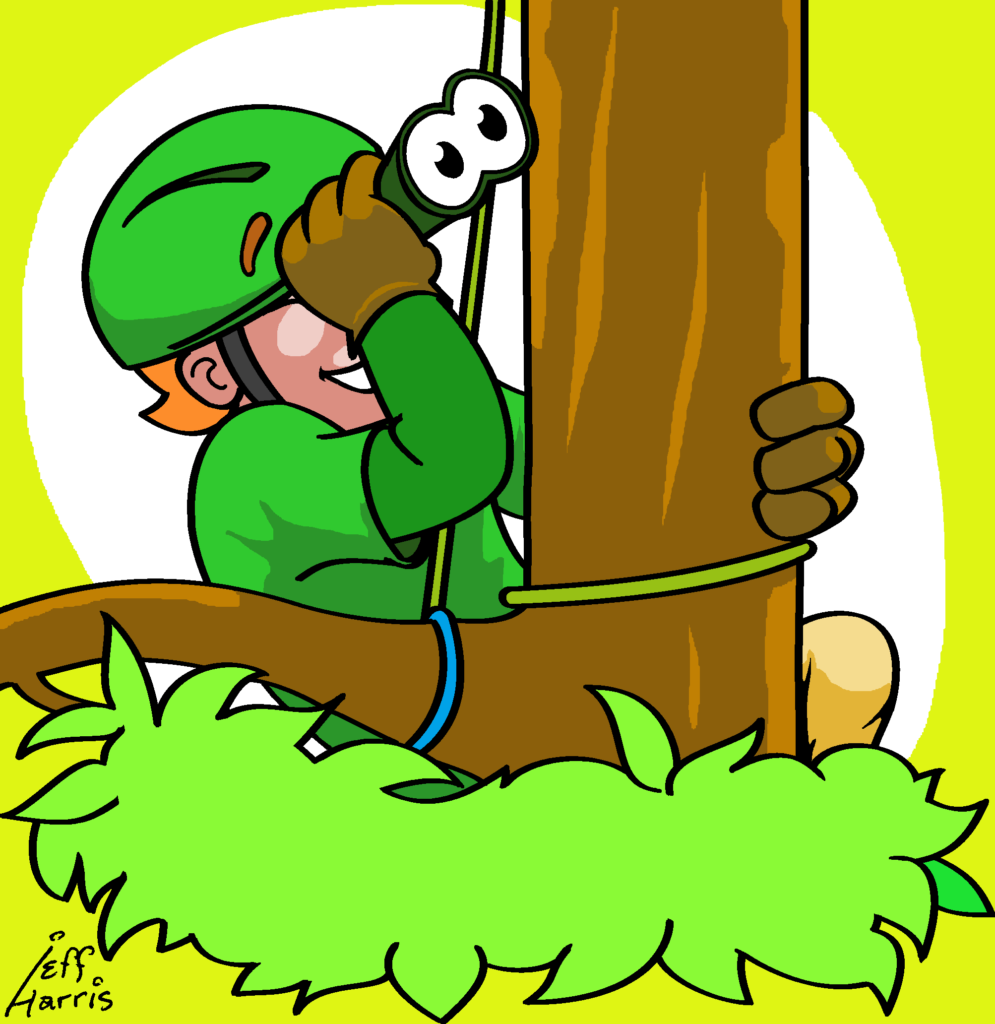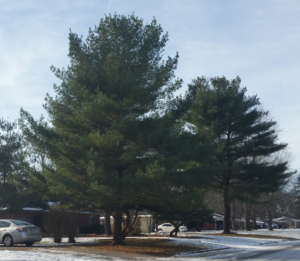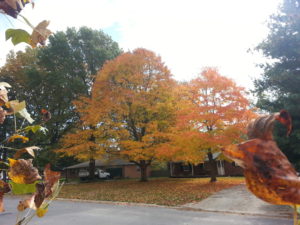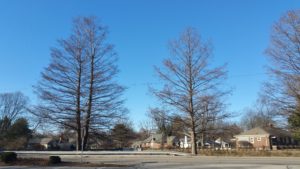Sandy loves the diversity of trees that are native to Indiana! Whenever she gets a chance, she puts on her safety equipment and goes out with her fellow Arbor Rangers ™ to view and climb trees.
Trees come in all shapes and sizes and Indiana, for example, has over 100 native species!
Did you know that some of these Indiana tree species are in common with nearby states?
For instance, the Indiana State Tree, the Tulip Tree (also known as Yellow Poplar; scientific name, Liriodendron tulipifera), is also the State Tree of Kentucky and Tennessee! It is native from Connecticut and southern New York, westward to southern Ontario and northern Ohio, and south to Louisiana and northern Florida.
The most common types of trees in Indiana range from:
- CONIFER (a.k.a. EVERGREEN or Softwood) trees bear cones with embedded seeds and have needle-like or scale-like leaves that remain “ever” green throughout the year. Because these plants do not produce flowers, they are among the group of plants known as “Gymnosperms“.
- DECIDUOUS HARDWOOD (a.k.a. Broadleafed) trees which are trees with broader, flattened, “fan-like” leaves (simple or compound of various shapes and sizes). These are seed-producing plants, like conifers, but they differ because they bear flowers (some more distinctly than others) and thereby are among a larger diverse group of plants called “Angiosperms“. Most species’ leaves will change color before dropping off in the fall season. This is true in other cooler climate states, but rarer in warmer or tropical climate states.
- DECIDUOUS EVERGREEN trees which look like typical conifers, but surprisingly lose their foliage in the fall just like deciduous hardwood trees! These are also among the group of plants known as “Gymnosperms“.
Do Your TREE-Search!
Sandy has helped put together the following list of trees that are native to Indiana. Included are non-native, INVASIVE SPECIES.* This is a searchable & sortable list of conifers and hardwood trees featuring their Scientific Names as well as Common Names by which they are generally known and includes links to more tree information** by clicking on their Scientific and Common Names.
DEFINITIONS The list also reflects some quick tree facts, such as:
- Type: One of the three tree types: Conifer, Deciduous Hardwood, or Deciduous Evergreen.
- Leaf: The general type of leaf form.
- Simple – a single leaf blade joined by its stalk (or petiole) to a woody stem.
- Compound – a leaf that is itself composed of more than one leaflet and these leaflets are attached to its single leaf stalk.
- Needle-like – slender, sharp-pointed leaf.
- Scale-like – leaves with short overlapping segments.
- Branching: Briefly describes the general, characteristic, growth structure of the plant’s stems/branches.
- Alternate – branching that is staggered or not directly across from one another.
- Opposite – branches that are directly across from each other.
- Height: The approximate average maximum height the tree species may obtain at maturity.
- Spread: The approximate average maximum width the tree species may obtain at maturity.
- Fall Color: The general color of the foliage during the fall/winter season; leaves detach and drop from deciduous tree types. Find out Why Leaves Change Color.
- Hardiness Zones: Range of USDA Plant Hardiness Zones each plant has been reported to grow and usually thrive in. To learn more about hardiness zones, see our USDA Plant Hardiness Zone Map – INDIANA page.
HINT: Viewing the list on a small screen mobile device in portrait position may not display all columns. Try viewing this page with your device in landscape orientation to broaden your view of all featured columns of the tree list.
[table id=natvtreeIN /]
Native Trees of Indiana list compiled, created and copyright © 2017 Arbor Rangers, LLC.
Arbor Rangers, LLC would like to thank and acknowledge the following resources which made this compilation possible:
- Sally Weeks: “Native Trees of the Midwest“ (Second Edition) [ISBN 978-1-55753-572-6]
- Marion Jackson: “101 Trees of Indiana“ [ISBN 978-0-253-21694-6]
- Indiana University-Purdue University (Fort Wayne): Native Trees of Indiana River Walk website
- Elbert Little: “Field Guide to Trees: Eastern Region – North America“ [ISBN 0-394-50760-6]
- USDA Forest Service: “Silvics of North America“ (Agriculture Handbook 654) also their Natural Resources Conservation Service (NRCS) and Fire Effects Information System (FEIS) online databases
- Butler University: Indiana Plant Atlas
- University of Florida Environmental Horticulture: 680 Tree Fact Sheets
- Missouri Botanical Garden: Plant Finder
- Ohio DNR Forestry: Common Ohio Trees
- Virginia Tech: Dendrology factsheets (“vTree” database)
- Arbor Day Foundation: Tree Identification
- The Morton Arboretum: Tree and plant descriptions
- Indiana Invasive Species Council: Official IISC Invasive Plant List
- Rebecca Weller’s: Trees For Me website
- University of Texas at Austin/Lady Bird Johnson Wildflower Center: Native Plant Finder
- Illinois Wildflowers: Trees, Shrubs, and Woody Vines of Illinois
- Minnesota Wildflowers: Trees in Minnesota
- New England Wild Flower Society/Go Botany: Woody Plants
- Friends of the Louisiana State Arboretum: Featured Species
- Global Species website
- Dave’s Garden website
- With special THANKS to Lindsey Purcell, Urban Forest Specialist, Purdue University for his expert review!
Find additional resources here on our TEACHER and PARENT RESOURCES page.




